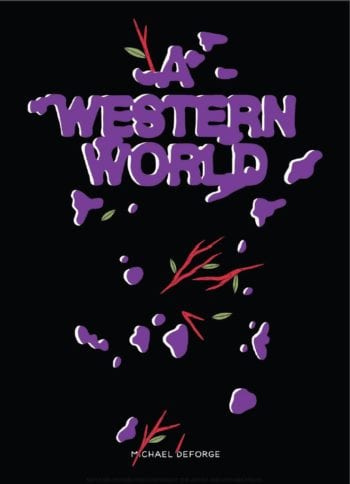The Curse of Charley Butters opens with the making of a death metal music video in the woods outside of suburban Toronto. With caked-on face paint and obscenely long, spiked bracelets, the band certainly look the part...but are really just wanna-be rockers who don’t even wanna-be all that badly. While filming, they stumble upon an abandoned cabin containing paintings and a set of diaries dating back to the 1960's, all of which belonged to an artist named Charley Butters who seemed to have dropped out of society. Reading through the diaries has a strange affect on Travis, the band’s loutish, irritable singer, who soon becomes obsessed with Butters to the point that it drives him to alcoholism, costing him his friendships, his job, his girlfriend. Everything.
This 340-page black and white paperback collects the original three books written and drawn by Zach Worton – The Disappearance of Charley Butters, The Search for Charley Butters and The Death of Charley Butters – which he began publishing with Conundrum Press in 2015. It draws a small bit of influence from the true story of Tom Thomson, an early 20th century painter whose career inspired the Canadian artist collective The Algonquin School (also known as The Group of Seven). Thomson died while off canoeing alone in the woods, sparking a lot of unfounded speculation about how he really died (the official cause of death was drowning). Worton’s fictional Charley Butters also disappears forever in the wilderness but he does so because he is tortured by an undiagnosed mental illness. We see glimpses of his story through entries from the diaries he left behind and Travis finds himself insatiably curious about how Butters finally ended up.

Worton is a talented young cartoonist whose brush-ink style is reminiscent of old comic strip artists like EC Segar or Frank King but filtered through their more modern creative descendants like Kevin Huizenga or Charles Forsman. His people, with their black dot Olive Oyl eyes are designed with clean, crisp lines and a cartoonist’s skill for observing mannerisms and detail to make their characters accessible. He has a few jarring stylistic quirks like how he uses about forty lines too many every time he draws hands or how he overthinks the mechanics of those eyes by tilting and skewing them in the direction they’re looking, giving the impression that Worton is still working out some cartooning kinks. His real strength is in his environments which are detailed and textured with cross-hatching and heavy brush work. His establishing shots of the woods in their inky darkness, splotched with leafy cover and scratched with barky texture are the best parts of the book.
While Worton’s art is a throwback to the early 20th century strips and the early 21st century cartoonists that emulate them, his story is also a throwback of sorts. The tale of a straight white man who runs away from all the responsibilities in life is a dying breed these days. Worton’s problem is that he falls into the trap of potential banality of his subject matter too easily. The opening scenes of the band vamping in the woods are so wonderfully drawn and such a dead-on replica of every cheesy metalhead ever that it’s a shame when we never see Travis and his bandmates interact like this for the rest of the book. The promise of a conflict between the world of metal music and Travis’ obsession with the diaries doesn’t really play out in any significant way. Death Metal, the lowest of low-brow music, would be the perfect foil to set against the high-brow art world that drove Charley Butters mad. but Worton doesn’t seem interested in examining art in any more meaningful or insightful way than he does mental health or alcoholism.
 There is just not enough reason to care about either Travis or Charley’s descents into madness. Travis’s relationships with his bandmates are strained from the beginning so once he starts drinking they don’t have far to go. There is an interesting conflict when Travis and Stuart, the guy filming the music video in the beginning, partner to make a documentary about Butters and end up having a falling out over it, but unfortunately that happens mostly in-between chapters and then goes nowhere. A seemingly important romantic relationship in the first book with a woman named Kat also ends off-panel and loses significance.
There is just not enough reason to care about either Travis or Charley’s descents into madness. Travis’s relationships with his bandmates are strained from the beginning so once he starts drinking they don’t have far to go. There is an interesting conflict when Travis and Stuart, the guy filming the music video in the beginning, partner to make a documentary about Butters and end up having a falling out over it, but unfortunately that happens mostly in-between chapters and then goes nowhere. A seemingly important romantic relationship in the first book with a woman named Kat also ends off-panel and loses significance.
Although it’s not fair to say no one should still be making stories about straight white males behaving badly and trying to find themselves, Charley Butters is a good example of how the bar needs to be raised these days to justify them. Travis asks himself at a particular low point: “Is there something completely missing from my life that I need this mystery to solve?” It’s a good question for him to ask and Worton seems to be trying to say that when it comes to alcoholism and mental illness, the answers to most questions are unsatisfying. The problem is that even a meaningless journey needs some meaning for a reader to latch on to, and it is not clear what either Travis or Worton’s journey has been about.







